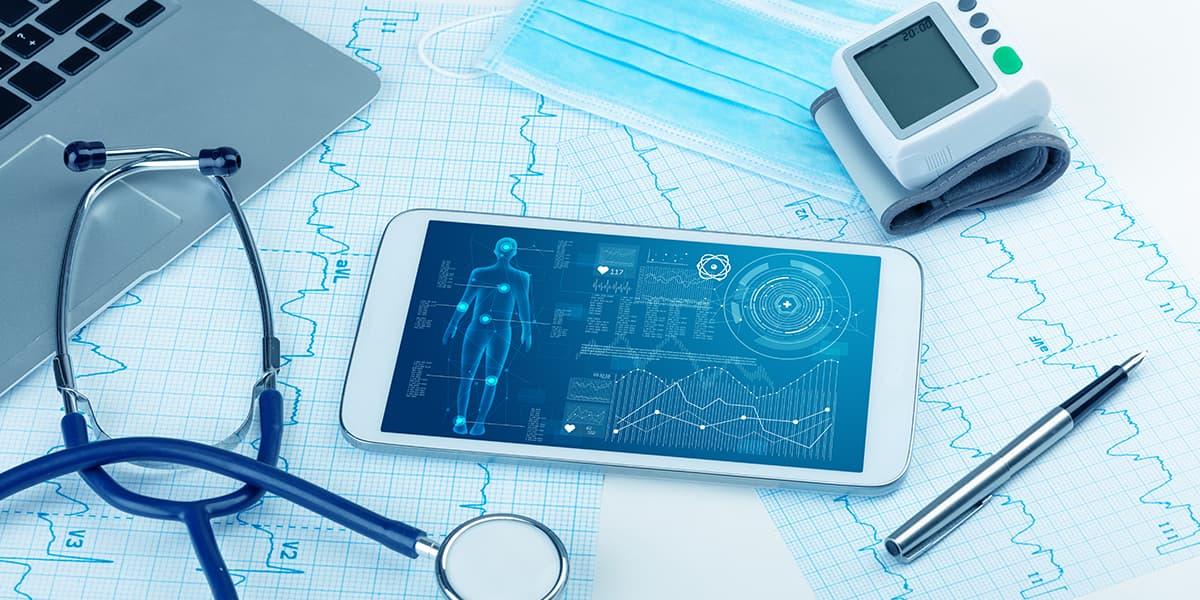A Look at the Current State of the Digital Healthcare Market, which is Expanding due to the COVID-19 Pandemic
Measuring Vital Data with Smartphones and Wearable Devices
The global COVID-19 pandemic has dramatically altered our lives and our values. The travel restrictions and quarantine measures put in place by governments around the world in response have resulted in the expansion of the digital healthcare industry. At the same time, this has led to people becoming more aware of preventing the spread of infection, boosting their immune systems, and general health promotion, which means more attention is being paid to the digital healthcare solutions that have been made possible by the advances in digital transformation (DX) and IoT. This article looks at the trends in the expanding digital healthcare market.
One of the solutions for preventing COVID-19 infection that became particularly symbolic is the IoT thermometer that was developed by a tech company in the United States. It connects to your smartphone via Bluetooth, making it possible to check the body temperature changes of users in particular regions in the cloud to investigate the spread of infection. Similarly in Japan, an app that uses Bluetooth to notify the user if they have come into close contact with a person who has been infected with COVID-19 has been developed.
Regarding wearable devices that can help prevent infection, there is now a coin-sized, disposable device available that can be attached to clothing and other locations to measure vital data such as body temperature, heart rate, and respiratory rate, and is being used in the early detection of possible infection. Designed with the monitoring of medical staff and patients at hospitals in mind, it won the Innovation Award at the Consumer Electronics Show (CES) that was held online in January 2021 in the United States. Another wearable device that has gone on the market can easily estimate changes in pulse oximetry, a measurement of oxygen saturation in the blood that acts as an indicator of the severity of pneumonia in COVID-19 patients.
A major Japanese telecommunications company is working with universities and other institutes to develop a system capable of collecting and analyzing health and medical data from smartphones and wearable devices. For example, one university is working with the telecoms giant to develop an algorithm that can predict the level of senility in the elderly from data such as their walking speed. The National Cerebral and Cardiovascular Center is also collaborating with them to develop an algorithm to detect signs and risk of disease from data such as blood pressure, lipids, and blood sugar levels.
According to US research agency IDC, about 125 million wearable devices were shipped worldwide from July to September 2020, up 35% from the same period in 2019, and mainly consisting of watch-type devices and in-ear devices.

Utilizing Sensing Technology for Disease Prevention and Health Management
The COVID-19 pandemic has also triggered a surge in demand for digital healthcare between doctors and patients. Social distancing has been proven as an effective method for preventing infection, which has led to an increase in online medical consultations, which in turn has led to an expansion of the digital healthcare market.
Subsequently, it has become an opportune time to leverage IoT to collect biometric data from daily life and utilize it for disease prevention and health promotion. A major Japanese tech company started a trial service that suggests meals and more based on a person's personal biometric data. The user simply needs to stand in front of a "smart mirror" and their body temperature, heart rate, and stress level are measured, then the mirror suggests functional foods and other products that are considered beneficial for that person thanks to a link with a health-related databank in the cloud.
Development of a system in which a sensor built into toilet seats can collect biometric data when the user uses the toilet is also underway. Data such as blood flow, heart rate, and skin condition are collected while the user is sitting on the toilet seat and analyzed by AI in the cloud. The results of the analysis can judge stress levels and lack of exercise, and are sent to the user's smartphone.
The toilet seat sensor is a device that is garnering attention for its ability to collect various kinds of biometric data, and by passing a weak electric current through the user's body it is also possible to measure visceral body fat and skeletal muscle ratio. It is also hoped that continuous analysis of the odor of urine and stool and tracking the changes could lead to the early detection of illnesses.
The Global Digital Healthcare Market is Showing Growth
According to Report Ocean, the global digital healthcare market reached 120.2 billion USD (about 13.5 trillion yen) in 2020, and is growing at an average annual rate of 21.4% from 2021. It is projected to reach 480.1 billion USD (about 53.5 trillion yen) in 2027. The digital healthcare market is being driven by the emergence of new mobile equipment and wearable devices, the adoption of IoT in the medical and health promotion sectors, and the introduction of sophisticated medical information systems and electronic medical record systems, and the market is expected to grow even more as new technological innovations come along.

